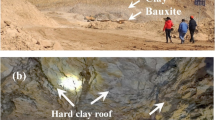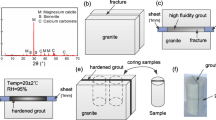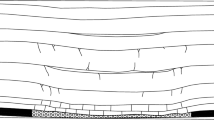Abstract
Water disaster prevention and gas extraction in coal mining need to accurately determine the development strata of mining fractures. The borehole resistivity method (BRM) is an advanced technology to monitor the dynamic development of mining fractures during the construction of underground engineering. However, the huge difference between the physical property of the sealing material for the BRM and the surrounding rock affects the accuracy of monitoring data. With the gradual expansion of the application range of BRM, the requirements for the monitoring accuracy of the technology are getting higher and higher. Therefore, it is an urgent engineering problem to develop a new rock-like material (RLM) to further improve the monitoring accuracy of BRM. This study aims to optimize the RLM mix design for BRM by introducing a few conductive ingredients such as steel slag (SS), graphite powder (GP), and multi-walled carbon nanotubes (MWCNs). To be consistent with the field conditions, the curing temperature, curing age, and triaxial stress loading and unloading scheme of RLM were designed to align with the temperature change, monitoring period for BRM, and stress conditions in the coal mines. The porosity, resistivity, and triaxial compressive strength of all rock-like material samples were tested. The results show that optimal mixture of the RLM is 41.9% SS, 27.9% cement, 1.4% GP, and 0.9% MWCNs in mass fraction. At this mixture, the RLM exhibited similar electrical resistivity, triaxial compressive strength, and shear strength to the country rock surrounding the boreholes. RLM not only improves the monitoring accuracy of the fracture development throughout the entire construction process but also fills the gap of lacking sealing materials with physical properties similar to rock, which were previously limited to adding salt to cement as the sealing material.
Highlights
-
A rock-like material that can improve the accuracy of fracture monitoring is optimized.
-
The effects of graphite powder and multi-walled carbon nanotubes on the properties of rock-like materials were discussed.
-
The influence of temperature on porosity, resistivity, and compressive strength of optimized rock-like materials was studied.
-
The rock-like material studied is a tentative exploration in the study of sealing materials in the field of fracture monitoring.












Similar content being viewed by others
Data availability
The datasets used and/or analyzed during the current study available from the corresponding author on reasonable request.
References
Adda-Bedia M, Amar MBen (2001) Fracture spacing in layered materials. Phys Rev Lett 86(25):5703–5706. https://doi.org/10.1103/physrevlett.86.5703
Adhikary DP, Guo H (2015) Modelling of longwall mining-induced strata permeability change. Rock Mech Rock Eng 48(1):345–359. https://doi.org/10.1007/s00603-014-0551-7
Banthia N, Djeridane S, Pigeon M (1992) Electrical resistivity of carbon and steel micro-fiber reinforced cements. Cement Concrete Res 22(5):804–814. https://doi.org/10.1016/0008-8846(92)90104-4
Biskri Y, Achoura D, Chelghoum N, Mouret M (2017) Mechanical and durability characteristics of High Performance Concrete containing steel slag and crystalized slag as aggregates. Constr Build Mater 150:167–178. https://doi.org/10.1016/j.conbuildmat.2017.05.083
Buckman J, Chudi O, Lewis H, Couples G, Huang TS, Jiang ZY (2019) Synthetic digital rock methods to estimate the impact of quartz cementation on porosity & permeability: assessment of miocene turbidite sandstones and prediction of deeper oligocene sandstones. Niger delta basin. J Pet Sci Eng 184:106538. https://doi.org/10.1016/j.petrol.2019.106538
Chen Y, Guo WB, Zuo JP, Heng S, Dou R (2021) Effect of triaxial loading and unloading on crack propagation and damage behaviors of sandstone: an experimental study. Rock Mech Rock Eng 54(12):6077–6090. https://doi.org/10.1007/s00603-021-02605-w
Cheng GW, Yang TH, Liu HY, Wei LK, Zhao Y, Liu YL, Qian JW (2020) Characteristics of stratum movement induced by downward longwall mining activities in middle-distance multi-seam. Int J Rock Mech Min 136:104517. https://doi.org/10.1016/j.ijrmms.2020.104517
Cho N (2008) Discrete element modeling of rock pre-peak fracturing and dilation. University of Alberta
Deceuster J, Delgranche J, Kaufmann O (2006) 2D cross-borehole resistivity tomographies below foundations as a tool to design proper remedial actions in covered karst. J Appl Geophys 60(1):68–86. https://doi.org/10.1016/j.jappgeo.2005.12.005
Douma LANR, Regelink JA, Bertotti G, Boersma QD, Barnhoorn A (2019) The mechanical contrast between layers controls fracture containment in layered rocks. J Struct Geol 127:103856. https://doi.org/10.1016/j.jsg.2019.06.015
Farcas C, Galao O, Navarro R, Zornoza E, Baeza FJ, Del Moral B, Pla R, Garces P (2021) Heating and de-icing function in conductive concrete and cement paste with the hybrid addition of carbon nanotubes and graphite products. Smart Mater Struct 30(4):045010. https://doi.org/10.1088/1361-665X/abe032
Fulham-Lebrasseur R, Sorelli L, Conciatori D (2020) Development of electrically conductive concrete and mortars with hybrid conductive inclusions. Constr Build Mater 237:117470. https://doi.org/10.1016/j.conbuildmat.2019.117470
Ge ZL, Mei XD, Lu YY (2015) Optimization and application of sealing material and sealing length for hydraulic fracturing borehole in underground coal mines. Arab J Geosci 8(6):3477–3490. https://doi.org/10.1007/s12517-014-1488-6
Guan XC, Bai S, Li H, Ou JP (2020) Mechanical properties and microstructure of multi-walled carbon nanotube-reinforced cementitious composites under the early-age freezing conditions. Constr Build Mater 233:117317. https://doi.org/10.1016/j.conbuildmat.2019.117317
Guo X, Xue S, Zheng CS, Li YB (2022) Experimental research on influencing factors and ratio optimization of new high fluidity borehole sealing material. The Vjesn 29(2):511–518. https://doi.org/10.17559/TV-20200921150837
Gupta S, Pel L, Kopinga K (2014) Crystallization behavior of NaCl droplet during repeated crystallization and dissolution cycles: An NMR study. J Cryst Growth 391:64–71. https://doi.org/10.1016/j.jcrysgro.2014.01.016
Han BG, Zhang LY, Ou JP (2010) Influence of water content on conductivity and piezoresistivity of cement-based material with both carbon fiber and carbon black. J Wuhan Univ Technol 25(1):147–151. https://doi.org/10.1007/s11595-010-1147-z
Han BG, Ding SQ, Yu Y (2015) Intrinsic self-sensing concrete and structures: a review. Measurement 59:110–128. https://doi.org/10.1016/j.measurement.2014.09.048
Hoek E, Brown ET (1980) Empirical strength criterion for rock masses. J Geotech Eng Div ASCE 106(9):1013–1035. https://doi.org/10.1061/AJGEB6.0001029
Hoek E, Carranza-Torres C, Corkum B (2002) Hoek-Brown failure criterion–2002 edition. In: Proceedings of NARMS-TAC Conference, pp 267–273
Hou WG, Cheng JL, Li D et al (2021) Determination of gas drainage layer in overburden rock of coal seam based on dynamic monito-ring by borehole resistivity method: a case study of Liyazhuang coal mine. Sci Technol Eng 21(17):7046–7052 (in Chinese)
Huang WP, Li C, Zhang LW, Yuan Q, Zheng YS, Liu Y (2018) In situ identification of water-permeable fractured zone in overlying composite stratum. Int J Rock Mech Min Sci 105:85–97. https://doi.org/10.1016/j.ijrmms.2018.03.013
Iqbal S, Ali I, Room S, Ali Khan S, Ali A (2019) Enhanced mechanical properties of fiber reinforced concrete using closed steel fibers. Mater Struct 52(3):1–10. https://doi.org/10.1617/s11527-019-1357-6
Jiao WX, Sha AM, Liu ZZ, Li W, Jiang W, Qin W, Hu YJ (2020) Study on thermal properties of steel slag asphalt concrete for snow-melting pavement. J Clean Prod 277:123574. https://doi.org/10.1016/j.jclepro.2020.123574
Karacan C, Goodman G (2009) Hydraulic conductivity changes and influencing factors in longwall overburden determined by slug tests in gob gas ventholes. Int J Rock Mech Min Sci 46(7):1162–1174. https://doi.org/10.1016/j.ijrmms.2009.02.005
Li DQ, Hossein M, Serkan S, Paul CH, Mostafa A (2018) Parametric study of fully grouted cable bolts subjected to axial loading. Can Geotech J 56(10):1514–1525. https://doi.org/10.1139/cgj-2018-0470
Li DQ, Faradonbeh RS, Lv A, Wang XY, Roshan R (2022a) A data-driven field-scale approach to estimate the permeability of fractured rocks. Int J Min Reclam Environ 36(10):671–687. https://doi.org/10.1080/17480930.2022.2086769
Li ZX, Guo TT, Chen YZ, Lu Y, Niu XJ, Yang X, Jin LH (2022b) Study on road performance and electrothermal performance of poured conductive asphalt concrete. Adv Mater Sci Eng 2022:2462126. https://doi.org/10.1155/2022/2462126
Liang ZZ, Song WC, Liu WT (2020) Theoretical models for simulating the failure range and stability of inclined floor strata induced by mining and hydraulic pressure. Int J Rock Mech Min Sci 132:104382. https://doi.org/10.1016/j.ijrmms.2020.104382
Liu SH, Li QL, Xie GS, Li LH, Xiao HL (2016) Effect of grinding time on the particle characteristics of glass powder. Powder Technol 295:133–141. https://doi.org/10.1016/j.powtec.2016.03.030
Liu K, Xie HZ, Xu PX, Wang Z, Bai HJ, Wang F (2019a) The thermal and damage characteristics of an insulated-conductive composite structure for the heated bridge deck for snow-melting. Constr Build Mater 216:176–187. https://doi.org/10.1016/j.conbuildmat.2019.05.002
Liu SH, Wu MQ, Rao MJ, Li LH, Xiao HL (2019b) Preparation, properties, and microstructure of graphite powder-containing conductive concrete. Strength Mater+ 51(1):76–84. https://doi.org/10.1007/s11223-019-00052-1
Liu J, Li QP, Wang XR, Wang ZQ, Lu SQ, Sa Z, Wang H (2022a) Dynamic multifractal characteristics of acoustic emission about composite coal-rock samples with different strength rock. Chaos Solitons Fractals 164:112725. https://doi.org/10.1016/j.chaos.2022.112725
Liu YB, Cheng JL, Jiao JJ, Meng XX (2022b) Feasibility study on multi-seam upward mining of multi-layer soft-hard alternate complex roof. Environ Earth Sci 81(17):1–20. https://doi.org/10.1007/s12665-022-10537-z
Luo T, Wang Q (2021) Effects of graphite on electrically conductive cementitious composite properties: A review. Materials 14(17):4798. https://doi.org/10.3390/ma14174798
Ma Q, Liu X, Tan Y, Elsworth D, Shang J, Song D, Liu X, Yan F (2023) Numerical study of mechanical properties and microcrack evolution of double-layer composite rock specimens with fissures under uniaxial compression. Eng Fract Mech 289:109403. https://doi.org/10.1016/j.engfracmech.2023.109403
Maslehuddin M, Sharif AM, Shameem M, Ibrahim M, Barry MS (2003) Comparison of properties of steel slag and crushed limestone aggregate concretes. Constr Build Mater 17:105–112. https://doi.org/10.1016/s0950-0618(02)00095-8
Mo LW, Zhang F, Deng M, Jin F, Al-Tabbaa A, Wang AG (2017) Accelerated carbonation and performance of concrete madewith steel slag as binding materials and aggregates. Cement Concrete Comp 83:138–145. https://doi.org/10.1016/j.cemconcomp.2017.07.018
Mohammad JK, Ahmed K, Hashim RR, Zhang PF (2013) The impact of carbon nano-fiber modification on asphalt binder rheology. Constr Build Mater 30:257–264. https://doi.org/10.1016/j.conbuildmat.2011.12.022
Monosi S, Ruello ML, Sani D (2016) Electric arc furnace slag as natural aggregate replacement in concrete production. Cement Concrete Comp 66:66–72. https://doi.org/10.1016/j.cemconcomp.2015.10.004
Netinger I, Varevac D, Bjegović D, Morić D (2013) Effect of high temperature on properties of steel slag aggregate concrete. Fire Safety J 59:1–7. https://doi.org/10.1016/j.firesaf.2013.03.008
Palankar N, Ravi Shankar AU, Mithun BM (2016) Durability studies on eco-friendly concrete mixes incorporating steel slag as coarse aggregates. J Clean Prod 129:437–448. https://doi.org/10.1016/j.jclepro.2016.04.033
Pan P, Wu SP, Xiao FP, Pang L, Xiao Y (2015) Conductive asphalt concrete: a review on structure design, performance, and practical applications. J Intell Mater Syst Struct 26(7):755–769. https://doi.org/10.1177/1045389X14530594
Shishegaran A, Daneshpajoh F, Taghavizade H, Mirvalad S (2020) Developing conductive concrete containing wire rope and steel powder wastes for route deicing. Constr Build Mater 232:117184. https://doi.org/10.1016/j.conbuildmat.2019.117184
Singh N, Singh SP (2019) Electrical resistivity of self consolidating concretes prepared with reused concrete aggregates and blended cements. J Build Eng 25:100780. https://doi.org/10.1016/j.jobe.2019.100780
Song XB, Shang SS, Chen DD, Gu XL (2017) Multi-walled carbon nanotube reinforced mortar-aggregate interfacial properties. Constr Build Mater 133:57–64. https://doi.org/10.1016/j.conbuildmat.2016.12.034
Sun YJ, Zuo JP, Karakus M, Wen JH (2020) A novel method for predicting movement and damage of overburden caused by shallow coal mining. Rock Mech Rock Eng 53(4):1545–1563. https://doi.org/10.1007/s00603-019-01988-1
Wang QK, Chen YZ, Li FX, Sun T, Xu BB (2006) Microstructure and properties of silty siliceous crushed stone-lime aerated concrete. J Wuhan Univ Technol 21(2):17–20
Wang XJ, Wu YK, Zhu PH, Ning T (2021) Snow melting performance of graphene composite conductive concrete in severe cold environment. Materials 14(21):6715. https://doi.org/10.3390/ma14216715
Wen S, Huang R, Zhang C, Zhao X (2023) Mechanical behavior and failure mechanism of composite layered rocks under dynamic tensile loading. Int J Rock Mech Min Sci 170:105533. https://doi.org/10.1016/j.ijrmms.2023.105533
Won JP, Kim CK, Lee SJ, Lee JH, Kim RW (2014) Thermal characteristics of a conductive cement-based composite for a snow-melting heated pavement system. Compos Struct 118:106–111. https://doi.org/10.1016/j.compstruct.2014.07.021
Wu JM, Liu JG, Yang F (2015) Three-phase composite conductive concrete for pavement deicing. Constr Build Mater 75:129–135. https://doi.org/10.1016/j.conbuildmat.2014.11.004
Wu RX, Hu ZA, Hu XW (2020) Principle of using borehole electrode current method to monitor the overburden stratum failure after coal seam mining and its application. J Appl Geophys 179:104111. https://doi.org/10.1016/j.jappgeo.2020.104111
Wu SC, Li LP, Zhang XP (2021) Rock mechanics. Higher education press, Beijing, pp 173–182
Xie HP, Zhou HW, Liu JF, Gao F, Zhang R, Xue DJ, Zhang Y (2011) Mining-induced mechanical behavior in coal seams under different mining layouts. J China Coal Soc 36(7):1067–1074. https://doi.org/10.13225/j.cnki.jccs.2011.07.025
Xie HP, Zhao XP, Liu JF, Zhang R, Xue DJ (2012) Influence of different mining layouts on the mechanical properties of coal. Int J Min Sci Technol 22(6):749–755. https://doi.org/10.1016/j.ijmst.2012.12.010
Xu SL, Liu JT, Li QH (2015) Mechanical properties and microstructure of multi-walled carbon nanotube-reinforced cement paste. Constr Build Mater 76:16–23. https://doi.org/10.1016/j.conbuildmat.2014.11.049
Xu SL, Lyu Y, Xu SJ, Li QH (2019) Enhancing the initial cracking fracture toughness of steel-polyvinyl alcohol hybrid fibers ultra high toughness cementitious composites by incorporating multi-walled carbon nanotubes. Constr Build Mater 195:269–282. https://doi.org/10.1016/j.conbuildmat.2018.10.133
Yang H, Ouyang J, Cao P, Chen W, Han B, Ou J (2022) Effect of steel wool and graphite on the electrical conductivity and pavement properties of asphalt mixture. J Mater Civ Eng 34(3):04021466. https://doi.org/10.1061/(ASCE)MT.1943-5533.0004105
Ying JW, Huang YJ, Gao X, Qi XB, Sun YD (2021) Effects of coarse and fine aggregates on long-term mechanical properties of sea sand recycled aggregate concrete. Front Struct Civ Eng 15(3):754–772. https://doi.org/10.1007/s11709-021-0711-2
Yu MF, Lourie O, Dyer MJ, Moloni K, Kelly TF, Ruoff RS (2000) Strength and breaking mechanism of multiwalled carbon nanotubes under tensile load. Science 287(5453):637–640. https://doi.org/10.1126/science.287.5453.637
Zhang J, Liu SD, Chen QH (2019) Application of Cross-borehole Integrated geophysical methods for the detailed investigation of karst in urban metro construction. J Environ Eng Geoph 24(4):525–536. https://doi.org/10.2113/JEEG24.04.03.525
Zhang C, Jin GH, Liu C (2020) Sealing performance of new solidified materials: mechanical properties and stress sensitivity characterization of pores. Adv Polym Tech 2020:1–16. https://doi.org/10.1155/2020/5397697
Zhang T, Chen QZ, Zhang JZ, Zhou XP (2023) Influences of mechanical contrast on failure characteristics of layered composite rocks under true-triaxial stresses. Rock Mech Rock Eng 56:5363–5381. https://doi.org/10.1007/s00603-023-03341-z
Zhao PX, Zhuo RS, Li SG, Lin HF, Shu CM, Bin LW, Jia YY, Suo L (2020) Fractal characteristics of gas migration channels at different mining heights. Fuel 271:117479. https://doi.org/10.1016/j.fuel.2020.117479
Zhou DJ, Wang JH, Gao Y, Zhang L (2017) Corrosion behavior of tinplate in NaCl solution under different temperature. Int J Electrochem Sc 12(1):192–205. https://doi.org/10.20964/2017.01.28
Acknowledgements
The first author has been awarded CSC scholarship to conduct part of their PhD research at WA School of Mines: Minerals, Energy, and Chemical Engineering. An opportunity for this collaborative research at both institutes in China and Australia is acknowledged.
Funding
This work was supported by the Young Science and Technology Talents Growth Project of Education Department of Guizhou Province (Q, J, H. KYZ[2022]124) and the Natural Scientific Research Project of Guizhou Provincial Department of Education (Q, J, H. KYZ[2015]340) and supported by China Scholarship Council.
Author information
Authors and Affiliations
Contributions
All persons who have made substantial contributions to the work reported in the manuscript are listed as follows: Yuben Liu: data curation, methodology, writing—original draft. Zhu Gao: writing—reviewing and funding acquisition. Junjun Jiao: conceptualization and methodology. Mohammad Waqar Ali Asad: writing—reviewing and conceptualization. Michael Hitch: writing—reviewing. Danqi Li: data curation and writing—reviewing.
Corresponding author
Ethics declarations
Conflict of Interest
The authors declare that they have no known competing financial interests or personal relationships that could have appeared to influence the work reported in this paper.
Additional information
Publisher's Note
Springer Nature remains neutral with regard to jurisdictional claims in published maps and institutional affiliations.
Rights and permissions
Springer Nature or its licensor (e.g. a society or other partner) holds exclusive rights to this article under a publishing agreement with the author(s) or other rightsholder(s); author self-archiving of the accepted manuscript version of this article is solely governed by the terms of such publishing agreement and applicable law.
About this article
Cite this article
Liu, Y., Gao, Z., Jiao, J. et al. Optimizing a Rock-Like Material Mix Design for Enhancing the Mining Fracture Monitoring Accuracy of Borehole Resistivity Method. Rock Mech Rock Eng (2024). https://doi.org/10.1007/s00603-024-03778-w
Received:
Accepted:
Published:
DOI: https://doi.org/10.1007/s00603-024-03778-w




